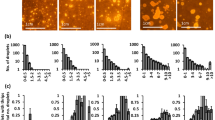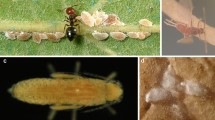Abstract
The sap-sucking mirid, Falconia intermedia (Distant) (Hemiptera: Miridae), released as a biological control agent of Lantana camara L. (Verbenaceae) in South Africa in 1999, has established at only one site. We investigated the role of induced plant defences as a possible explanation for this lack of establishment. F. intermedia inoculated plants from the five test varieties significantly increased the toughness of their new leaves compared to control plants. Additionally, plants from three L. camara varieties significantly increased leaf trichome density on new leaves after prolonged feeding by F. intermedia, significantly reducing F. intermedia oviposition, survival and feeding damage. The defensive responses were systemic and rapidly induced about eight weeks after insect feeding. We suggest that these leaf quality responses played a role in the non-establishment of F. intermedia in South Africa.



Similar content being viewed by others
References
Agrawal AA, Spiller DA (2004) Polymorphic buttonwood: effects of disturbance on resistance to herbivores in green and silver morphs of a Bahamian shrub. Am J Bot 91:1990–1997
Baars J-R (2002) Biological control initiatives against Lantana camara L. (Verbenaceae) in South Africa: an assessment of the present status of the programme, and an evaluation of Coelocephalapion camarae Kissinger (Coleoptera: Brentidae) and Falconia intermedia Distant (Heteroptera: Miridae), two new candidates natural enemies for release on the weed. PhD thesis, Department of Zoology and Entomology, Rhodes University, South Africa
Baars J-R, Urban AJ, Hill MP (2003) Biology, host range, and risk assessment supporting release of Falconia intermedia (Heteroptera: Miridae), a new biocontrol agent for Lantana camara. Biol Control 28:282–292
Coley PD, Bateman ML, Kursar TA (2006) The effects of plant quality on caterpillar growth and defense against natural enemies. Oikos 115:219–228
Dalin P, Bjorkman C (2003) Adult beetle grazing induces willow trichome defence against subsequent larval feeding. Oecologia 134:112–118
Dalin P, Agren J, Björkman C, Huttunen P, Kärkkäinen K (2008) Leaf trichome formation and plant resistance to herbivory. In: Schaller A (ed) Induced plant resistance to herbivory. Springer, Netherlands
Day MD, McAndrew TD (2003) The biology and host range of Falconia intermedia (Hemiptera: Miridae), a potential biological control agent for Lantana camara (Verbenaceae) in Australia. Biol Sci Tech 13:13–22
Day MD, Zalucki MP (2009) Lantana camara Linn. (Verbenaceae). In: Muniappan R, Reddy GVP, Raman A (eds) Biological control of tropical weeds using arthropods. Cambridge University Press, New York
Endo N, Hirakawa I, Wada T, Tojo S (2007) Induced resistance to the common cutworm, Spodoptera litura (Lepidoptera: Noctuidae) in three soybean cultivars. Appl Entomol Zool 42:199–204
Gatehouse JA (2002) Plant resistance towards insect herbivores: a dynamic interaction. New Phytol 156:145–169
Heshula ULP (2005) Establishment and impact of the sap-sucking mirid, Falconia intermedia (Distant) (Hemiptera: Miridae) on Lantana camara (Verbenaceae) varieties in the Eastern Cape Province, South Africa. MSc thesis, Department of Zoology and Entomology, Rhodes University, South Africa
Heshula ULP (2009) Induced plant responses of different Lantana camara L. (Verbenaceae) varieties to herbivory by Falconia intermedia (Distant) (Hemiptera: Miridae). PhD thesis, Department of Zoology and Entomology, Rhodes University, South Africa
Heystek F (2006) Laboratory and field host utilization by established biological control agents of Lantana camara L. in South Africa. M.Sc. Thesis, Department of Zoology and Entomology, Rhodes University, South Africa
Heystek F, Olckers T (2003) Establishment and impact of Falconia intermedia (Hemiptera: Miridae) on Lantana camara in South Africa. In: Cullen JM, Briese DT, Kriticos DJ, Lonsdale WM, Morin L, Scott JK (eds) Proceedings of the eleventh international symposium on biological control of weeds, April 27–May 2, 2003. CSIRO, Canberra, p 606
Karban R, Baldwin IT (1997) Induced responses to herbivory. University of Chicago Press, Chicago
Palmer WA, Pullen KR (1998) The host range of Falconia intermedia (Distant) (Hemiptera: Miridae): a potential biological control agent for Lantana camara L. (Verbenaceae). Proc Entomol Soc Wash 100:633–635
Schoonhoven LM, van Loon JJA, Dicke M (2005) Insect–plant biology, 2nd edn. Oxford University Press, New York
Southwood TRE (1986) Plant surfaces and insects—an overview. In: Juniper B, Southwood TRE (eds) Insects and plant surfaces. Edward Arnold, London
StatSoft Inc (2008) STATISTICA (data analysis software system), version 8.0. http://www.statsoft.com
Straus SY, Agrawal AA (1999) The ecology and evolution of plant tolerance to herbivory. Trends Ecol Evol 14:179–185
Traw MB, Dawson TE (2002) Differential induction of trichomes by three herbivores of black mustard. Oecologia 113:526–532
Wheeler GS (2001) Host plant quality factors that influence the growth and development of Oxyops vitiosa, a biological control agent of Melaleuca quinquenervia. Biol Control 22:256–264
Wheeler GS, Center TD (1996) The influence of hydrilla leaf quality on larval growth and development of the biological control agent Hydrellia pakistanae (Diptera: Ephydridae). Biol Control 7:1–9
Acknowledgments
The authors thank Charles Willemse, Nkosinathi Mazungula and Simon Aphane, Unathi and Nkosi-Nathi Heshula for field assistance and general assistance in the laboratory. Funding by National Research Foundation (NRF) and Working for Water (WfW) and Rhodes University is gratefully acknowledged.
Author information
Authors and Affiliations
Corresponding author
Additional information
Handling Editor: John Scott
Rights and permissions
About this article
Cite this article
Heshula, L.U.P., Hill, M.P. The effect of Lantana camara leaf quality on the performance of Falconia intermedia . BioControl 56, 925–933 (2011). https://doi.org/10.1007/s10526-011-9359-5
Received:
Accepted:
Published:
Issue Date:
DOI: https://doi.org/10.1007/s10526-011-9359-5




